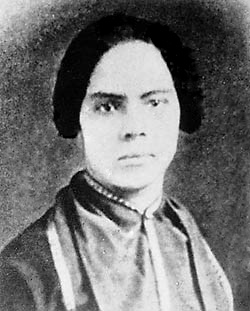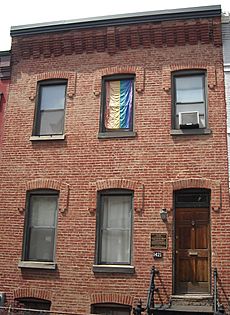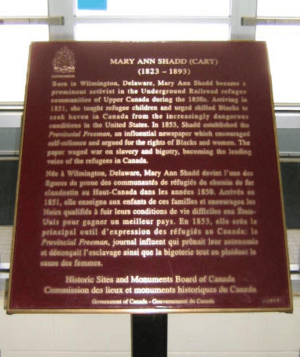Mary Ann Shadd facts for kids
Quick facts for kids
Mary Ann Shadd Cary
|
|
|---|---|
 |
|
| Born | Mary Ann Shadd October 9, 1823 Wilmington, Delaware, U.S. |
| Died | June 5, 1893 (aged 69) Washington, D.C., U.S. |
| Resting place | Columbian Harmony Cemetery |
| Occupation | Anti-slavery activist, journalist, publisher, teacher, lawyer |
| Language | English |
| Alma mater | Howard University (School of Law) |
| Spouse | Thomas F. Cary (m. 1856) |
| Children | 2 |
| Parents | Abraham D. Shadd Harriet Burton Parnell |
| Relatives | Eunice P. Shadd (sister), Isaac Shadd (brother), Garrison W. Shadd (brother) |
Mary Ann Shadd Cary (born October 9, 1823 – died June 5, 1893) was an amazing American-Canadian woman. She fought against slavery, wrote for newspapers, and even started her own. She was also a teacher and a lawyer!
Mary Ann Shadd Cary made history in many ways:
- She was the first Black woman to publish a newspaper in North America.
- She was the first woman to publish a newspaper in Canada.
- She was the second Black woman to go to law school in the United States.
She edited a newspaper called The Provincial Freeman, which started in 1853. This paper was published weekly in southern Ontario, Canada. It promoted ideas like equality and education for Black people in both Canada and the United States.
Mary's family helped people escape slavery through the Underground Railroad. After a law called the Fugitive Slave Act of 1850 was passed, her family moved to Canada. Mary Ann later returned to the U.S. during the American Civil War. There, she helped recruit soldiers for the Union army. She taught herself a lot, then went to Howard University Law School. She spent her whole life fighting for civil rights for African Americans and women.
Contents
Early Life and Education
Mary Ann Shadd was born in Wilmington, Delaware, on October 9, 1823. She was the oldest of 13 children. Her parents, Abraham Doras Shadd and Harriet Burton Parnell, were free African Americans.
Her father, Abraham Shadd, was a shoemaker. He was very active in the Underground Railroad, helping people escape slavery. He also worked for civil rights and was a leader in the American Anti-Slavery Society.
Mary's family home often gave shelter to people escaping slavery. When it became illegal to teach African-American children in Delaware, her family moved to Pennsylvania. There, Mary went to a Quaker school. In 1840, she started her own school for Black children. She also taught in other cities like Norristown, Pennsylvania, and New York City.
After the Fugitive Slave Act of 1850 was passed, her family moved to Canada West (now part of Ontario). Her father, Abraham, even became one of the first Black men elected to political office in Canada in 1858.
Fighting for Change
In 1848, a famous abolitionist named Frederick Douglass asked people for ideas to improve life for African Americans. Mary Ann, who was only 25, wrote to him. She said, "We should do more and talk less." She felt frustrated that many meetings were held to discuss slavery, but not enough real change happened. Douglass published her letter in his newspaper, The North Star.
While living in Windsor, Canada, Mary Ann started a school that welcomed both Black and white students. At that time, public schools in Ontario did not allow Black students. She taught children and young people during the day and adults in the evenings.
In 1852, Mary Ann wrote a pamphlet called A Plea for Emigration. This pamphlet talked about the good things about moving to Canada. It also shared opportunities for Black people in places like Mexico and the West Indies.
Starting The Provincial Freeman
In 1853, Mary Ann Shadd started an anti-slavery newspaper called The Provincial Freeman. Its motto was "Devoted to antislavery, temperance and general literature." The first issue was printed in Toronto, Ontario, on March 24, 1853. The newspaper was published every week for four years. It stopped because of money problems.
Mary Ann knew that people in the 1800s might not take a newspaper seriously if a woman's name was on it. So, she asked Samuel Ringgold Ward and Rev. Alexander McArthur to help her. Their names were on the newspaper's masthead, but Mary Ann did most of the work.
Her brother, Isaac Shadd, managed the newspaper's daily business. He was also a strong abolitionist.
Mary Ann traveled a lot in Canada and the United States to get more people to subscribe to the paper. She also asked for help for people who had escaped slavery. These trips were risky because of the Fugitive Slave Act. Free Black people could be captured by bounty hunters looking for escaped slaves.
Newspapers like The Provincial Freeman were very important. They gave Black Canadians a voice in the fight against slavery. Publishers like Mary Ann Shadd were dedicated to education and justice. They used their newspapers to share ideas and influence people. They faced many challenges to keep their papers going.
In 1854, Mary Ann put her own name on the newspaper's masthead. She also hired her sister to help edit. This change caused a lot of criticism, and Mary Ann had to resign the next year.
Life After the Civil War

Between 1855 and 1856, Mary Ann traveled across the United States. She gave speeches against slavery. She encouraged full racial integration through education and self-reliance. She told Black people to demand fair treatment. If that didn't work, she advised them to take legal action.
In 1855, she wanted to attend the Philadelphia Colored Convention. Women had never been allowed to attend before. The group had to vote on whether to let her be a delegate. She was only allowed in by a small number of votes. Even though she gave a speech, her presence was mostly left out of the official records because she was a woman.
In 1856, she married Thomas F. Cary, a barber from Toronto. He also worked with The Provincial Freeman. They had two children, a daughter named Sarah and a son named Linton.
After her husband died in 1860, Mary Ann Shadd Cary and her children moved back to the United States. During the American Civil War, she worked as a recruiting officer. She helped enlist Black volunteers for the Union Army in Indiana.
After the Civil War, she taught in Black schools in Wilmington. Then she moved to Washington, D.C., with her daughter. She taught in public schools there for fifteen years. Later, she went to Howard University School of Law. She graduated at age 60 in 1883. She became only the second Black woman in the U.S. to earn a law degree.
She wrote for newspapers like The National Era and The People's Advocate. In 1880, she started the Colored Women's Progressive Franchise.
Mary Ann Shadd Cary joined the National Woman Suffrage Association. She worked with famous leaders like Susan B. Anthony and Elizabeth Cady Stanton to fight for women's suffrage (the right to vote). She spoke before the House of Representatives Judiciary Committee. She also became the first African-American woman to vote in a national election.
She passed away in Washington, D.C., on June 5, 1893, from stomach cancer. She was buried in Columbian Harmony Cemetery.
Mary Ann Shadd Cary's Legacy
Mary Ann Shadd Cary left a lasting impact in both the United States and Canada.
In the U.S.:
- Her former home in Washington, D.C., was named a National Historic Landmark in 1976.
- She was honored during Women's History Month in 1987.
- In 1998, she was inducted into the National Women's Hall of Fame.
- A post office in Wilmington, Delaware, was named the Mary Ann Shadd Cary Post Office in 2021.
In Canada:
- She was named a Person of National Historic Significance. A plaque honoring her is in Chatham, Ontario.
- A Heritage Toronto plaque marks where she published The Provincial Freeman in Toronto.
- She is featured in Canada's citizenship test study guide.
- Mary Shadd Public School in Scarborough, Ontario, was named after her in 1985. Its motto is "Free to be...the best of me."
- In 2022, the University of Windsor in Ontario unveiled a bronze statue of Mary Ann Shadd Cary.
In 2018, The New York Times published a belated obituary for her, recognizing her important life. On October 9, 2020, her 197th birthday was celebrated with a Google Doodle in many countries.
See also
 In Spanish: Mary Ann Shadd para niños
In Spanish: Mary Ann Shadd para niños
- African American history
- African American literature
- List of African-American abolitionists
- List of African American writers
- Eunice P. Shadd
- Isaac Shadd


